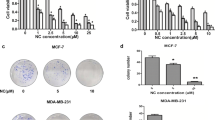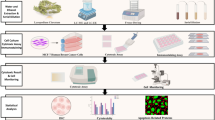Abstract
A number of extracts from Asian traditional medicinal herbs have been successfully used as therapeutic agents against cancers. In this study we assessed the effect of C5E on the proliferation inhibition and apoptosis of breast cancer cell lines. C5E is an ethanol extract from traditional Asian medicinal plants which have anticancer activity. Nonetheless, little is known about the underlying mechanism. Thus, we studied the mechanism of C5E-induced cell death in the human breast cancer cell line MDA-MB-231 and MCF7 cells. The cell survival rate was reduced in a concentration- and time-dependent manner, as assessed by direct cell counting. After incubation for 48 h, typical apoptotic morphological changes were observed by microscope. To determine the synergetic effect with doxorubicin, we co-treated C5E with doxorubicin in breast cancer cells, and flow cytometry revealed that co-treatment obviously enhanced sub-G1 arrest and apoptosis in MDA-MB-231 and MCF7 cells. Furthermore, we showed that pro-apoptotic marker cleaved PARP was synergistically increased with the combined treatment of doxorubicin and C5E in MDAMB-231, but not in MCF-7. These results suggest that the effect of combined treatment of C5E with doxorubicin on sub-G1 arrest and apoptosis in breast cancer cells could be exerted by the different mechanism and its potential use as a therapeutic agent will be helpful in treatment for breast cancer.
Similar content being viewed by others
References
Alkreathy HM, Damanhouri ZA, Ahmed N, Slevin M, and Osman AM (2012) Mechanisms of cardioprotective effect of aged garlic extract against Doxorubicin-induced cardiotoxicity. Integr Cancer Ther 11, 364–370.
Bak Y, Ham S, Baatartsogt O, Jung SH, Choi KD, Han TY et al. (2013) A1E inhibits proliferation and induces apoptosis in NCI-H460 lung cancer cells via extrinsic and intrinsic pathways. Mol Biol Rep 40, 4507–4519.
Bar-On O, Shapira M, and Hershko DD (2007) Differential effects of doxorubicin treatment on cell cycle arrest and Skp2 expression in breast cancer cells. Anticancer Drugs 18, 1113–1121.
Cai Y, Luo Q, Sun M, and Corke H (2004) Antioxidant activity and phenolic compounds of 112 traditional Chinese medicinal plants associated with anticancer. Life Sci 74, 2157–2184.
Chu Q, Satoh K, Kanamoto T, Terakubo S, Nakashima H, Wang Q et al. (2009) Antitumor potential of three herbal extracts against human oral squamous cell lines. Anticancer Res 29, 3211–3219.
Hong HJ, Liu JC, Chen PY, Chen JJ, Chan P, and Cheng TH (2012) Tanshinone IIA prevents doxorubicin-induced cardiomyocyte apoptosis through Akt-dependent pathway. Int J Cardiol 157, 174–179.
Ji Y, Rao Z, Cui J, Bao H, Chen C, Shu C et al. (2012) Ginsenosides extracted from nanoscale Chinese white ginseng enhances anticancer effect. J Nanosci Nanotechnol 12, 6163–6167.
Kanavos P (2006) The rising burden of cancer in the developing world. Ann Oncol 17Suppl 8, viii15–viii23.
Kang BR, Kim H, Nam SH, Yun EY, Kim SR, Ahn MY et al. (2012) CopA3 peptide from Copris tripartitus induces apoptosis in human leukemia cells via a caspase-independent pathway. BMB Rep 45, 85–90.
Kojima T and Barron JP (2010) Changes in the ethos of medical publications as reflected in progressive alterations in the uniform requirements for manuscripts submitted to biomedical journals (1979–2008). Chest 137, 1479–1482.
Kopp F, Oak PS, Wagner E, and Roidl A (2012) miR-200c sensitizes breast cancer cells to doxorubicin treatment by decreasing TrkB and Bmi1 expression. PLoS One 7, e50469.
Koutsilieris M, Reyes-Moreno C, Choki I, Sourla A, Doillon C, and Pavlidis N (1999) Chemotherapy cytotoxicity of human MCF-7 and MDA-MB 231 breast cancer cells is altered by osteoblast-derived growth factors. Mol Med 5, 86–97.
Kwon HK, Hwang JS, So JS, Lee CG, Sahoo A, Ryu JH et al. (2010) Cinnamon extract induces tumor cell death through inhibition of NFkappaB and AP1. BMC Cancer 10, 392.
Parkin DM, Nambooze S, Wabwire-Mangen F, and Wabinga HR (2009) Changing cancer incidence in Kampala, Uganda, 1991-2006. Int J Cancer 126, 1187–1195.
Rahman MA, Kim NH, Yang H, and Huh SO (2012) Angelicin induces apoptosis through intrinsic caspase-dependent pathway in human SHSY5Y neuroblastoma cells. Mol Cell Biochem 369, 95–104.
Shiao H, Kuo C, Horng J, Shih S, Chang S, Liao C, John H, Amancha PK, Chao Y, Hsieh H (2012) An Efficient, Mild and Scalable Synthesis of Bioactive Compounds Containing the Angelicin Scaffold. J Chin Chem Soc 59, 1548–1554.
Shoemaker M, Hamilton B, Dairkee SH, Cohen I, and Campbell MJ (2005) In vitro anticancer activity of twelve Chinese medicinal herbs. Phytother Res 19, 649–651.
Wang YA, Johnson SK, Brown BL, McCarragher LM, Al-Sakkaf K, Royds JA et al. (2008) Enhanced anti-cancer effect of a phosphatidylinositol-3 kinase inhibitor and doxorubicin on human breast epithelial cell lines with different p53 and oestrogen receptor status. Int J Cancer 123, 1536–1544.
Yang HL, Chen SC, Chen CS, Wang SY, and Hseu YC (2008) Alpinia pricei rhizome extracts induce apoptosis of human carcinoma KB cells via a mitochondria-dependent apoptotic pathway. Food Chem Toxicol 46, 3318–3324.
Zhao S, Wu J, Wang C, Liu H, Dong X, Shi C et al. (2013) Intraoperative fluorescence-guided resection of high-grade malignant gliomas using 5-aminolevulinic Acid-induced porphyrins: a systematic review and metaanalysis of prospective studies. PLoS One 8, e63682.
Author information
Authors and Affiliations
Corresponding author
Rights and permissions
About this article
Cite this article
Lee, S., Han, S., Park, J.S. et al. Herb mixture C5E aggravates doxorubicin-induced apoptosis of human breast cancer cell lines. J Korean Soc Appl Biol Chem 56, 567–573 (2013). https://doi.org/10.1007/s13765-013-3195-5
Received:
Accepted:
Published:
Issue Date:
DOI: https://doi.org/10.1007/s13765-013-3195-5




